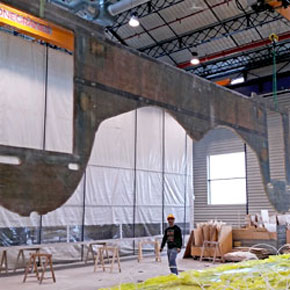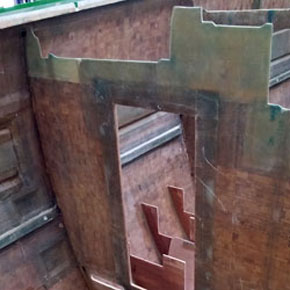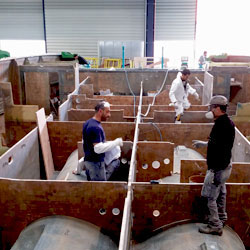 We asked Antoine Quertinmont, responsible for the installation of the hull structure, to explain the various stages of this operation.
We asked Antoine Quertinmont, responsible for the installation of the hull structure, to explain the various stages of this operation.
Once the hull has been produced, the next step is the installation of the hull structure. This step is essential to provide the hull’s rigidity. Without these bulkheads, the hull would not be sufficiently robust. This structure also makes it possible, once completed, to organise the boat’s layout to receive, the various modules that will form the interior spaces of the SEVENTY 7. “The bulkhead structure” requires great precision. The boat’s modules, produced alongside, will “lock” the bulkheads. If the bulkheads are not placed perfectly, the module will not fit together correctly.
The various stages:
We begin by installing the catamaran’s two structural bulkheads: the mast bulkhead and the engine-room bulkhead. They will provide to the hull some rigidity. We placed all the floor frames (small wood bulkheads) that are stiffened by a composite process (laminating), which fit closely to the bottom of the hull, thus rendering the structure more robust.
Once all the bulkheads are in place, the bridgedeck structure is laid on top. It will subsequently support the deck, which will then be installed on it, ensuring perfect rigidity of the catamaran and the durability of the deck.
Antoine Quertinmont :
A Lagoon employee for 2 years, Antoine is now a Technician in the Composite methods office. He is responsible for several tasks on the SEVENTY 7, in particular the production of the deck, the coachroof, small composite parts and the hull structure.
The composite methods team is responsible for all of the composite aspects on the Lagoon production site in Bordeaux: bill of materials, preparation of materials, logistics, management of subcontracting, documentation and monitoring of operators.


